
Cloudflare vs. CloudFront vs. Edgio—A Comparison of the Leading CDNs
There are many CDN platforms out there, but, at the core, each serves the same goal—to make websites faster by utilizing distributed networks of edge servers in locations close to the users accessing them. But once you look under the hood, it becomes clear that each CDN platform uses slightly different means.
Many of today’s CDNs do much more than distribute content—they offer many other features for improved security, analytics and development. And as content evolves into more dynamic formats and is viewed through a fragmented ecosystem of devices, choosing the right CDN that works best for your specific business and type of content (e.g., static assets vs. dynamic data / JSON, etc.) is more important than ever. This post will hopefully shed some light on the subject and compare the two popular CDN platforms, Cloudflare and Cloudfront with Edgio.
Speed sells
Running a fast website is no longer some fancy, superfluous gimmick. It is becoming a viable element of the SEO arms race. Google has always paid attention to site load speeds and ranked websites based on performance. But now it’s time to take action as we know that from 2021 onwards, site speed will be a critical element of SEO ranking.
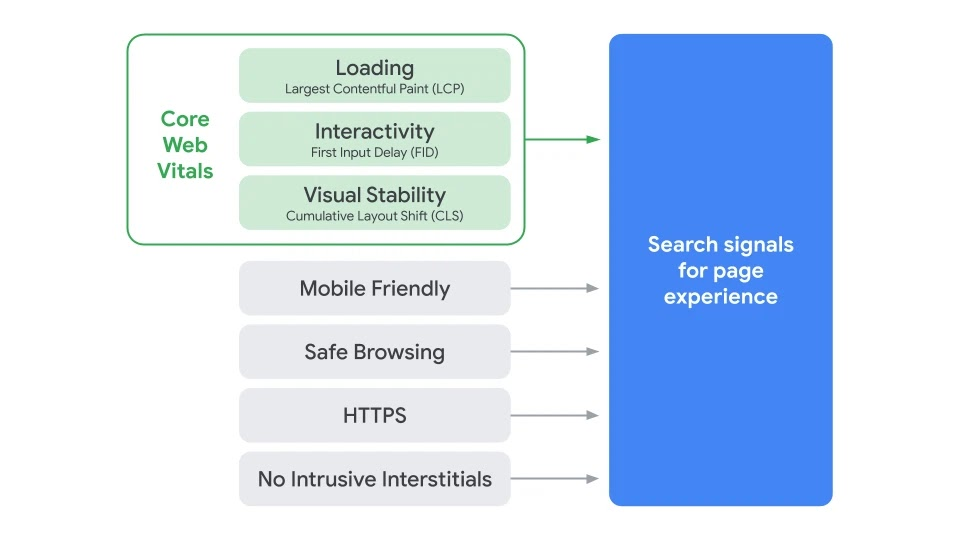
Google’s Page Experience Update introduces new metrics called Core Web Vitals (CWV) to measure the page’s loading, interactivity and visual stability times. Source: Google Webmaster Central Blog
Many players will soon feel the consequences of not offering a great experience, especially by eCommerce site operators, which tend to be image-rich and have unique features that slow them down, like real-time inventory lookups and dynamic pricing. According to Google’s own research, just a 100ms improvement to mobile page loads boosts an eCommerce website’s conversion rate by 8.4%. Slow websites will slide down the SERP page and possibly suffer million-dollar losses.
The problem with today’s CDNs
CDNs were originally built to serve the needs of a completely different internet reality: websites were lighter and consisted mainly of text and images, which hardly ever changed. On the other hand, today's Web is a fickle beast: it is vast and more complex than ever. Websites are progressively more complex, larger, database-driven and packed with sophisticated media, CSS stylesheets, JavaScript and a myriad of third-party APIs. At the same time, consumers’ expectations around speedy browsing experiences still hold. And while increasingly harder to meet—they are as important as ever.
The increasing complexity of websites creates its own share of new challenges for CDN providers. CDNs must evolve to support this crazy pace of evolution and provide infrastructure and features that make the new, dynamic and image-heavy pages run quickly and make great browsing experiences possible. Modern CDNs must provide support for richer and more sophisticated content and evolving protocols and formats while protecting websites from DDoS attacks, which are growing in scale and sophistication.
Let’s now have a look at the popular CDNs Cloudflare and Cloudfront, as well as the Edgio, and see if they’re up to the challenge.
Cloudflare
Cloudflare positions itself as a lower-cost CDN. It offers a global presence and unique performance capabilities and is known for a relatively strong focus on security. Cloudflare is user-friendly, easy to set up, affordable, and makes a pledge to meet the future needs of the businesses using it. It can optimize content beyond static assets and comes with various security features.
Their global CDN infrastructure accelerates the internet applications and mobile experience, ensuring application availability. Lastly, they operate a network of 200 data centers in different countries to reduce latency and improve the browsing experience for users.
Cloudflare key features
Among other things, Cloudflare accelerates websites by removing unnecessary characters from HTML, JavaScript, and CSS to reduce the size of the files of a website. A reduced-size file will load faster. Cloudflare also uses local storage to cache the objects needed to achieve the best rendering of websites.
Improved web experience: Rather than sending all the requests from different corners of the world onto a single server, requests are distributed on Cloudflare’s fleet of 200+ distributed servers. This distributed network balances the workload of the servers and keeps the content available to users.
Security. Protects your website from all sorts of online threats, including DDoS attacks.
Site analytics. Cloudflare offers analytics features to track the performance of your server. The built-in analytics allow you to keep tabs on your website traffic and track the avoided threats, bot traffic and much more.
Advanced WAF: Cloudflare also offers adequate security solutions for enterprise-level websites to combat severe attacks that can degrade the performance of a website. Web Application Firewall rules are automatically updated when security threats are discovered.
24/7 email and phone support is available, but only in the Enterprise plan.
Pros of Cloudflare:
Offers Argo smart routing
AutoMinify for smart content optimization
Web and browser optimization
SSL/TLS, Web Application Firewall and Cloudflare Access: identity and access management enabling secure application access without a VPN
Free shared SSL certificate
Unlimited and unmetered bandwidth consumption
Image optimization with Polish
PCI compliance and prioritizes email support for eCommerce websites.
Cons of Cloudflare:
Possibility of man-in-the-middle forgery
Unsolvable roadblocks can degrade performance
Lowered usability due to unnecessary captchas
Some advanced features like “log access,” are only available on expensive plans (Business and Enterprise).
Cloudflare pricing
Cloudflare is one of the most affordable ways to get a CDN for your site. It’s available in four plans: Free, Pro, Business, and Enterprise. The Pro plan is priced at $20 and the Business will cost you $200 per domain. The Enterprise plan is the “à la carte” type of offer, which is priced and custom-tuned independently to meet the specific needs of the client.
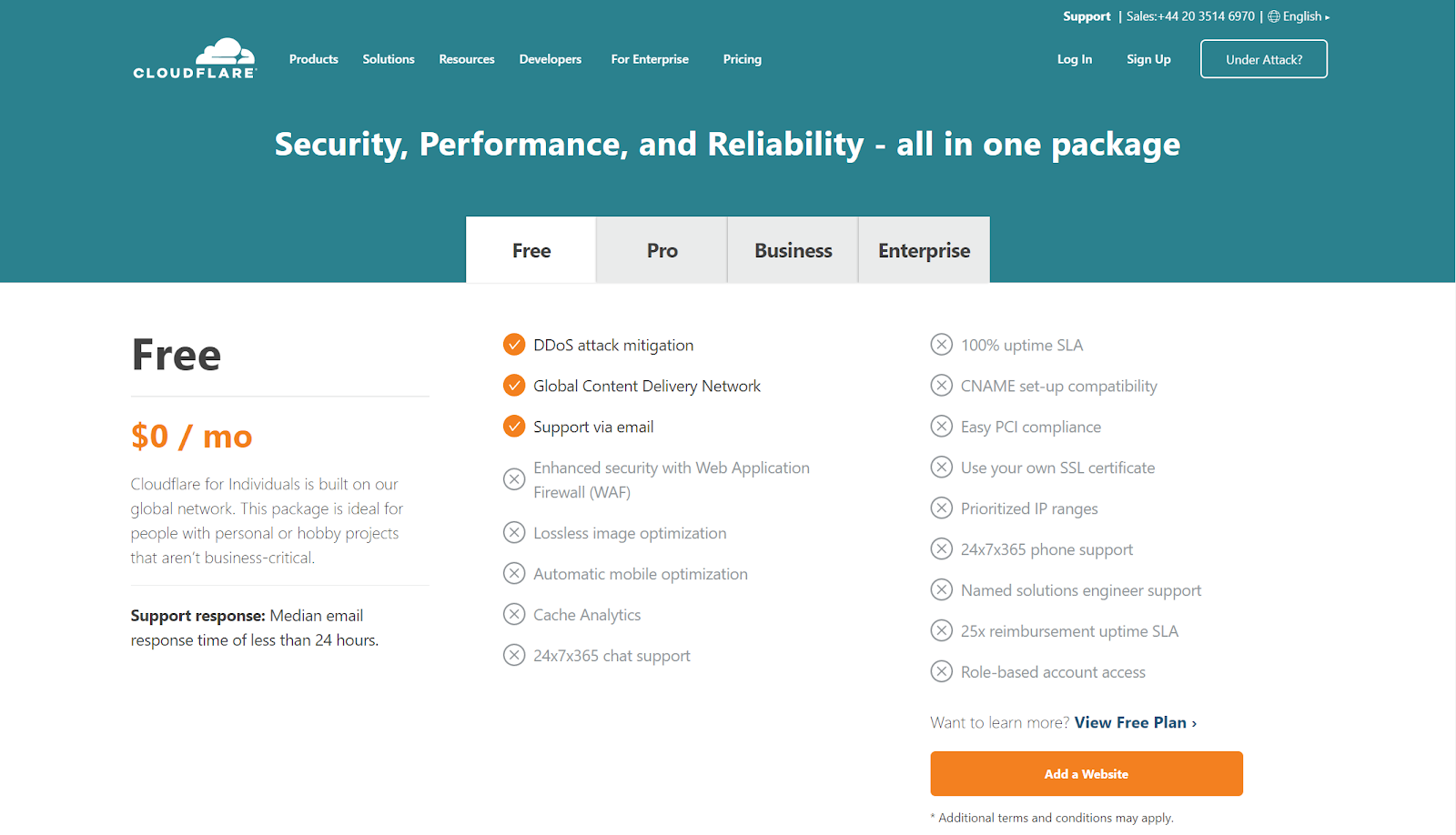
Cloudflare free tier plan
Cloudflare offers specific add-ons, like Dedicated SSL Certificates, Load Balancing, Argo Smart Routing, and Rate Limiting, which require an additional fee on top of the monthly subscription.
Interestingly, even Cloudflare’s free plan comes with basic DDoS protection. There is also more advanced DDoS protection available on the premium plans. It’s no surprise that Cloudflare’s free, unmetered plan is a major draw for many businesses looking to dip their toes in CDN technology and speed up their site with minimal effort. The switch to a paid plan—or a different CDN provider altogether—is always possible later on.
Why choose Cloudflare?
Cloudflare has a few advantages speaking in its favor:
It’s super affordable compared to the other CDN offerings and comes with a free tier.
Cloudflare is a good choice if you don't have a lot of dynamic images or want transparent WAF (and other security features).
Cloudflare has strong DDoS mitigation features (behind Akamai)
Cloudflare offers managed security services with an unbeatable price point.
CloudFront
Cloudfront is an extended service of Amazon. The beta version of Cloudfront launched in November 2008 and then re-launched in January 2009 with more attractive pricing. Needless to say, Amazon operates a really impressive number of edge locations and boasts a global network of edge locations spread across different regions of the world.
CloudFront key features
Amazon Cloudfront offers easy integration with other popular AWS services like Amazon S3, Amazon EC2, AWS Lambda@Edge, AWS Elemental MediaStore and MediaPackage, Amazon CloudWatch, etc., which is probably the best part of using CloudFront. It also works with the AWS Management Console.
On top of that, CloudFront offers these additional features:
Support for dynamic content, not just static assets.
Reports on cache statistics and popular objects, monitoring and alarming, usage charts and more.
Advanced security features and geo-restriction.
24/7 customer support (email and phone, although at an extra charge). By default, you just get access to a community forum.
Pros of CloudFront
Per-usage billing model makes it cost-effective
Seamless integration with other AWS services
A possibility to adjust the plan as you go depending on your current needs and pay only for the actual usage.
Edge servers in many different continents, including North America, South America, Asia, Europe, and Australia.
CloudFront generates valuable insights via report charts that allow you to track trends in data transfer and requests for your website.
Private content feature that lets you restrict access to your content.
Cons of CloudFront
Dynamic content caching at only 16% rate, which is better than the average 6% seen across traditional CDNs, but is still far too low to deliver speedy eCommerce or other database-driven websites.
Complex integration as compared to other CDNs
Although CloudFront’s pricing follows the pay-per-use model, scalability may cost you a pretty penny. A website with low traffic can easily afford the service, but an increase in traffic will quickly translate into a heavier bill.
Limited visibility into the underlying CloudFront structure.
Technical support is there, but not free for all.
CloudFront pricing
CloudFront is a pay-as-you-go CDN that helps you offer your end-user a seamless web experience by delivering them the content they requested via its nearest edge location. It offers three pricing tiers:
Free tier
New AWS customers receive 50 GB data transfer out and 2,000,000 HTTP and HTTPS requests each month for one year. The free tier is metered per month. Usage is aggregated across all AWS edge locations and automatically applied to your bill. Monthly usage does not roll over to the following period if not used.
One important caveat: you can only use the free plan for the first 12 months of becoming an AWS customer.
On-demand
Unlike other CDNs on the market, CloudFront costs less whereas Amazon’s costs are lower. Their prices vary across geographic regions and are based on the edge location through which your content is served. Usage tiers for data transfer are measured separately for each geographic region, as seen below:
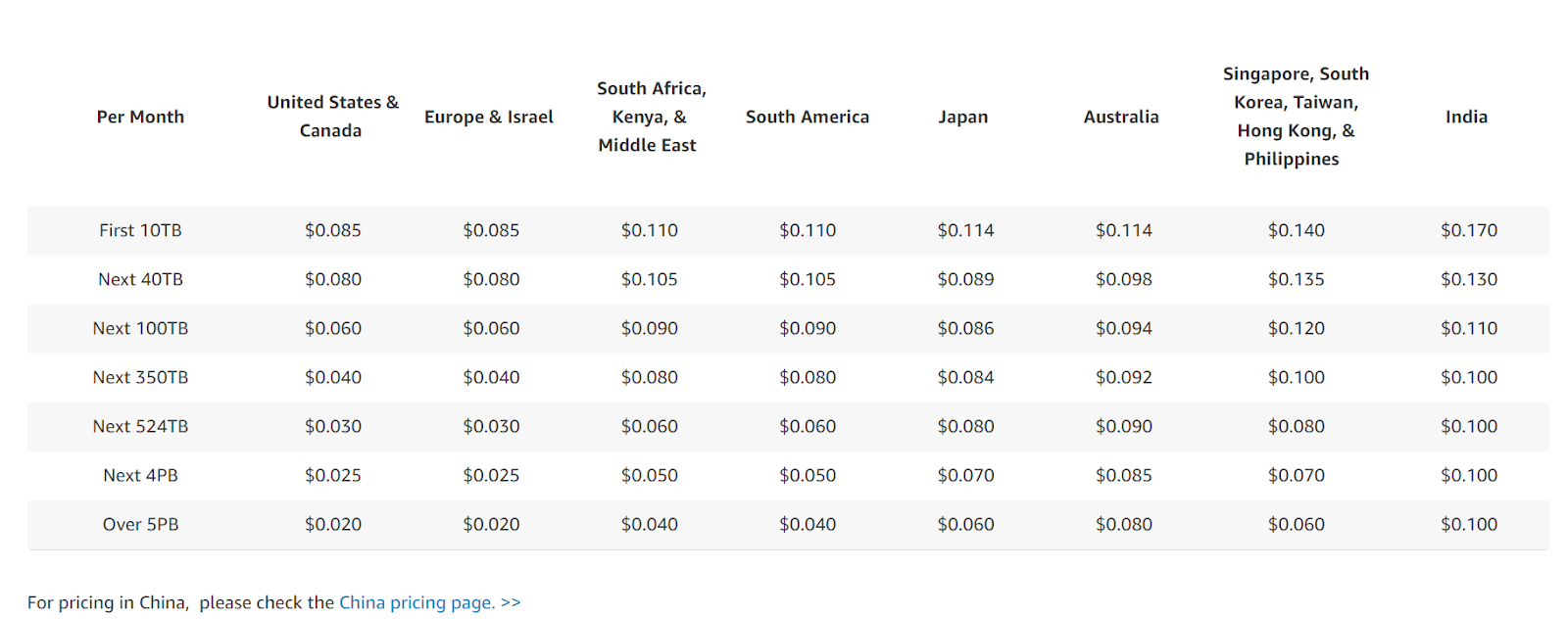
CloudFront On-Demand metered pricing model
Discounted pricing
Discounted pricing is available for customers expecting at least 10 TB of data transfer per month—over a period of 12 months or longer. CloudFront discounts will vary based on the amount of the commitment.
Why choose CloudFront?
CloudFront is a great choice for you if you’re after a seamless integration with other AWS services or your existing AWS stack (i.e., automation and metrics) and need a CDN that supports fast delivery of highly dynamic content.
It is also a good choice if you have much dynamically changing content, like eCommerce and Travel sites do, and want tight integration with your in-place pipeline. CloudFront supports pushing content to your edge locations with higher TTLS, which means DDoS becomes Amazon's problem.
If you have a diverse audience base and you want to offer efficient video streaming, CloudFront is also a great choice.
Edgio
Edgio is an infrastructure that enables large, database-driven websites to deliver sub-second experiences. And because it makes websites run faster, it unavoidably gets compared to the leading CDNs. There is nothing wrong with that, but it is with noting that Edgio is much more than just a CDN, and side-by-side comparisons don’t always do it justice. Edgio comes with an application-aware CDN-as-JavaScript, which can augment or even replace your current CDN and bring all the web security features you need to the edge. Edgio also comes with a bunch of dev-focused technologies that make the entire process of developing, deploying, previewing, experimenting on and running your headless frontend simple, including automated full-stack preview URLs, a serverless JavaScript backend for the frontend, advanced cache monitoring and more.
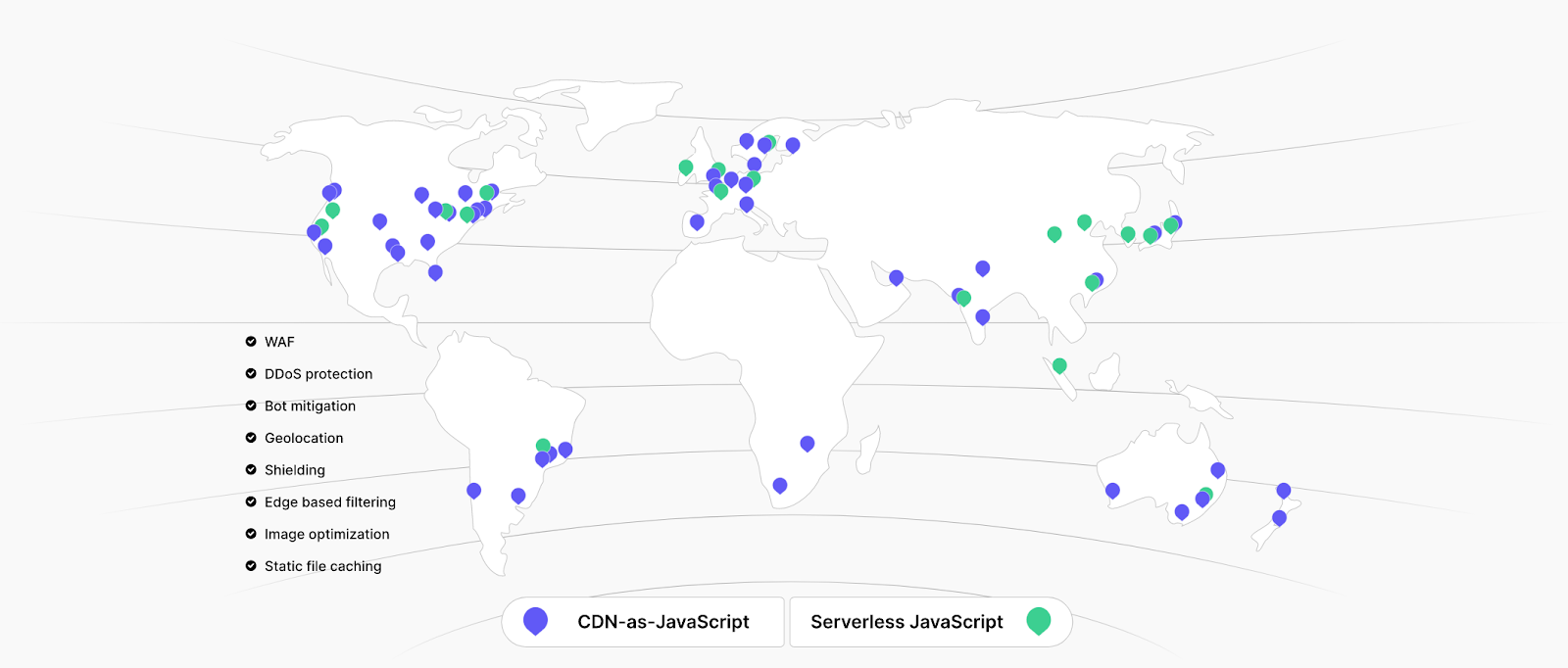
Edgio edge server locations
CDN-as-JavaScript is the world’s first JavaScript configurable CDN you configure right within routes.js. You’ll never have to go back to writing VCL, proprietary APIs, or trudging through a web console.
CDN-as-JavaScript, advanced predictive prefetching and, most importantly, complete control over caching at the edge allow websites on Edgio to remain 5 seconds ahead of shoppers’ taps. This is done by streaming cached dynamic content (i.e., JSON/SSR/HTML) from the edge to the browser before the shopper taps on a thing and based on what they are most likely to tap on next.

Edgio key features
For a complete rundown of all the bells and whistles with Edgio, see the table below.
Develop | Deploy | Preview | Run | Monitor | Experiment | Defend |
|---|---|---|---|---|---|---|
Use any framework | Full stack deploys: browser, server, and edge | Live preview URLs | CDN-as-JavaScript | Cache hit rate by route | Split tests at the edge | WAF |
No vendor lock-in | Atomic deploys and rollbacks | HTTPS URLs | 85 global edges | RUM speed by route | Iterative migration | DDoS protection |
Run edge rules locally | CLI and API | Custom domains | Prefetching | Log shipping | Canary deploy and feature flag support | Bot mitigation |
Github / Gitlab / Bitbucket integration | IP whitelisting | Advanced cache management | Smoke test alerts | |||
Live logs | 9 global Serverless JS PoPs | Conversion rate alerts | Roadmap: Browser security | |||
Latency-based traffic routing | ||||||
PCI DSS Level 1 99.95% SLA | Roadmap: Synthetic speed by route |
Edgio pricing
Edgio comes in two tiers: Free and Enterprise. Although only a limited version of the full deal, the former is the easiest and fastest way to get started and experience the key advantages of Edgio.
Enterprise pricing depends on numerous factors, such as your traffic and the number of environments and seats you need. At this point, you will need to contact Edgio directly to get a detailed cost estimate.
Why use Edgio?
Edgio can be used by any website but is primarily geared towards revenue-generating, database-driven sites, like eCommerce and Travel, which serve dynamic content to their users. On such sites, online shoppers typically wait for the JSON/HTML/SSR data, which makes up the specific size, color, and price of specific products. This is what makes traditional CDNs inefficient for such websites, as they don’t cache such dynamic data.
Edgio caches at least 95% of your dynamic data at the edge, and the improvement on websites using it is visible to the naked eye, as pages load (quite literally) in a blink of an eye. This is possible thanks to CDN-as-JavaScript, which puts data into the browser before it’s even needed. In other words, it’s a bit like always staying 5 seconds ahead of the person browsing your site.
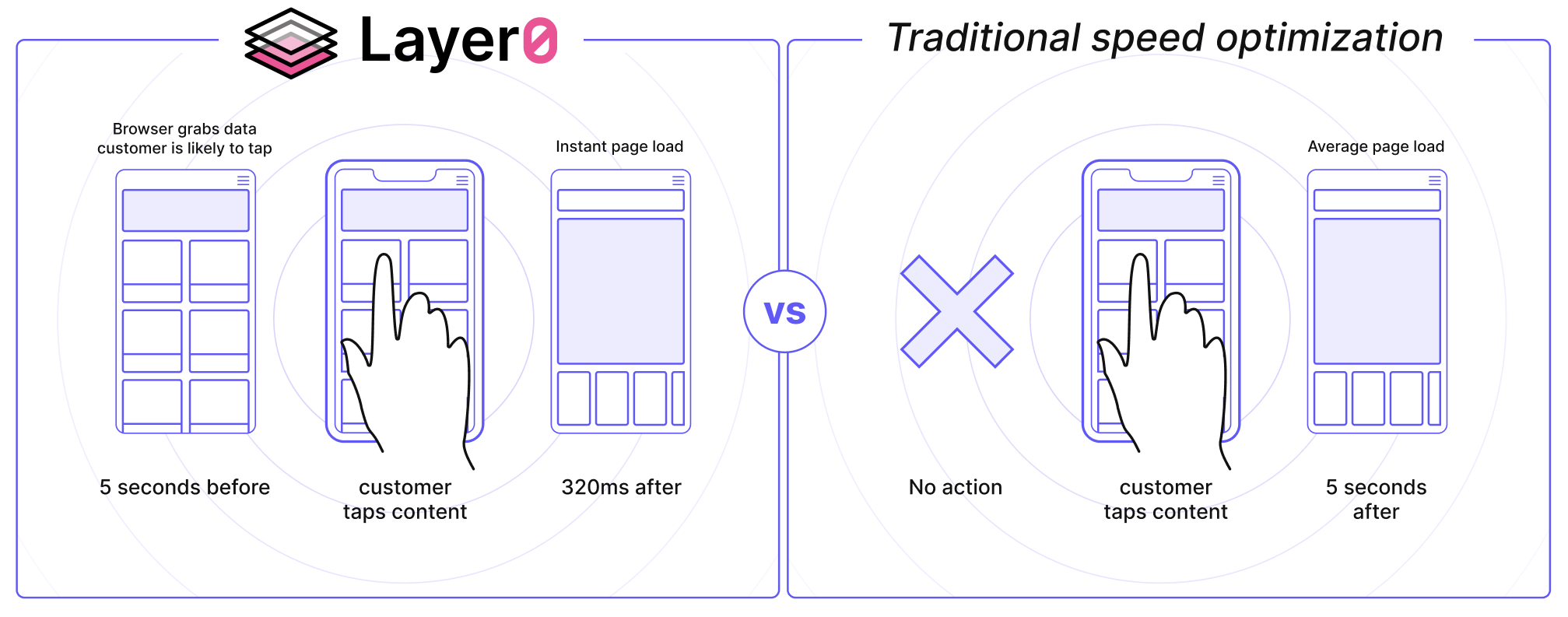
Schedule 1-on-1 Demo
Schedule a consultative conversation now to learn how the Edgio XDN can help you achieve sub-second page loads.
Edgio allows websites to achieve cache hit rates for dynamic data at the edge in the 95% range, while the sites that use traditional CDNs see a low 6%. For static content, the choice is simpler: CDNs can host the entire static content of your site and distribute it without necessarily having to replicate databases to other regions.
For users of dynamic web frameworks such as Next, Nuxt, React Storefront, Ruby on Rails, using CDNs becomes more interesting. These frameworks offer a server-side rendering of the pages, with JavaScript added to enhance the experience. While modern applications can be developed using these frameworks by extracting the view components out from the API, this monolithic approach is still incredibly productive. Furthermore, these frameworks already come with sophisticated, database-level caching systems.
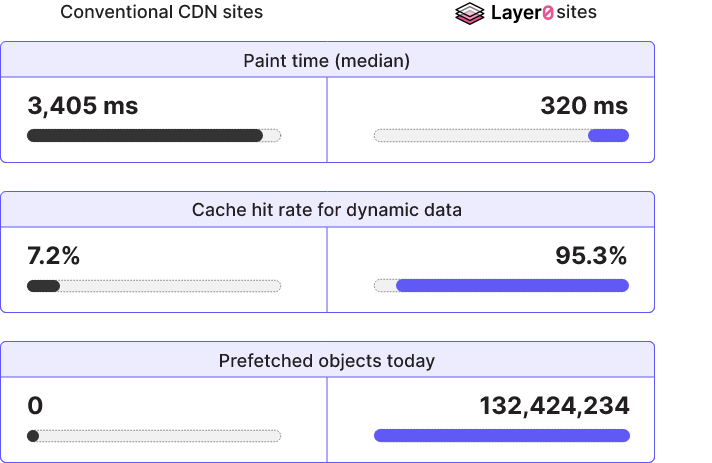
Which CDN is the fastest?
Most CDN providers will try to wow you with various serious-sounding features, raw numbers and comparison sheets, but they cannot guarantee actual real-life speeds. In other words, your mileage may vary, something you hear when the speed improvement is not quite what you expected. Edgio is one of the few technologies out there that promises actual results—we guarantee sub-500ms median paint times (LCP) for eCommerce websites, regardless of the frontend or backend systems or eCommerce platforms used.
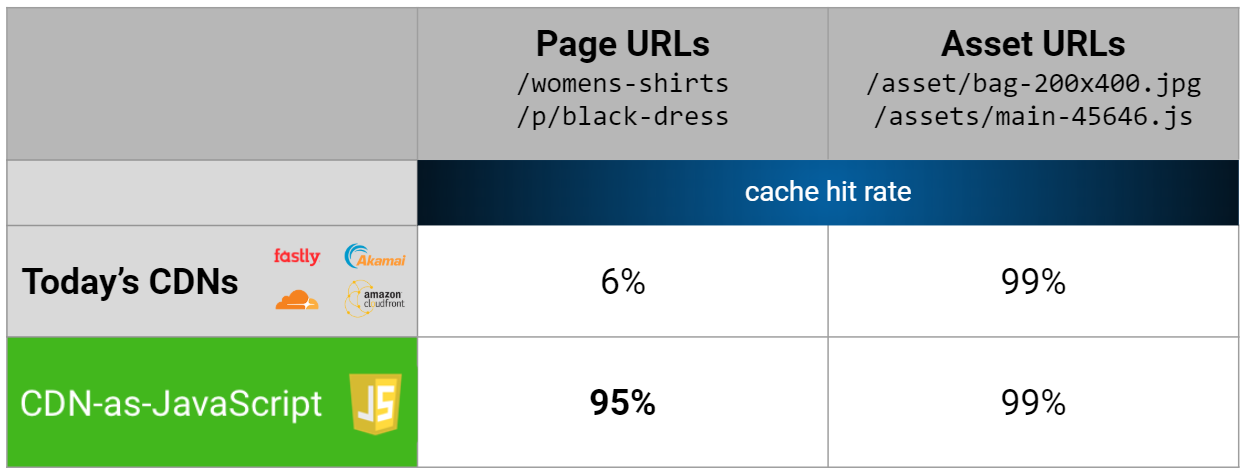
Today’s CDNs are built primarily with static content in mind. They understand asset URLs but not page routes.
Try before you buy
When looking for a CDN, claimed speed is not always the most reliable distinguishing factor. Raw numbers never tell the whole story—website performance is typically burdened with many variables beyond the platform’s control: time of day, size of your payload and the internet user's location relative to the edge.
And because the results may vary depending on so many things, the easiest way to buy a CDN is to test-drive it on your website—call the sales team and ask for a demo.
This assumption pretty much invalidates most comparison tables. When shopping for CDNs, getting lost in all these features and tech jargon is easy. But the most important thing to remember is that you’re probably looking for performance, not a CDN, for the sake of having one.
Comparison table:
CloudFront | Cloudflare | Edgio | |
|---|---|---|---|
Key information | |||
Who is it for? | SMB + Enterprise | SMB + Enterprise | SMB + Enterprise |
Instant setup | Yes | Yes | Yes
(takes less than 2 minutes) |
SLA | Yes | Yes | Yes |
Pricing | |||
Free tier/trial | Free tier | Free tier | Free tier |
eCommerce integration | Yes | Yes. Also, Shopify is integrated with Cloudflare out of the box. | Yes. The XDN works with every eCommerce platform or backend system |
Price | The free tier, On-demand tier (metered) and Discounted Pricing (declared minimum of 10 TB of data transfer per month for 12 months or longer. Discounts vary based on the amount of the commitment.) | Free, Pro, and Business plans are priced $0, $20, and $200 per domain, respectively. Enterprise pricing varies. Paid add-ons. | Free and Enterprise plans
(contact sales for detailed pricing) |
Security | |||
Anti-DDoS | AWS-Shield Covers Layer 3 and 4 attacks | Yes, Advanced DDoS Protection Layer 7 protection required pushing the "I'm under attack" button. | Yes. Layer 3 and 4 protection is available in the Free plan. Layer 7 is available in Enterprise. |
Web application firewall | Yes, AWS WAF | Yes | Yes |
Origin shield | No, CloudFront does request collapsing though | Yes Argo Paid extra (metered) or available as part of the Enterprise plan. | Yes, available in the Enterprise plan (Origin Cloaking) |
Special features | |||
Edge computing | Yes, Lambda@Edge | Yes, with Workers | Yes, with
|
Dynamic content caching | 16% | 6% | 95%+ |
Cache clearing | Purge all and by directory/file type (wildcards) | Possible (although somewhat problematic) | Yes |
Prefetching | No | Yes | Yes |
Compression/optimization | Yes Resend from the origin, or compress on edge | Yes, resend or compress on edge | Yes |
Performance | |||
Speed improvement compared to an average server | Hard to predict | Hard to predict | Guaranteed sub-second median page loads for large eCommerce websites |
Initial congestion window (initcwnd) | 10 packets | 10 packets | 10 packets |

Move to the Leading Edge
Get the information you need. When you’re ready, chat with us, get an assessment or start your free trial.